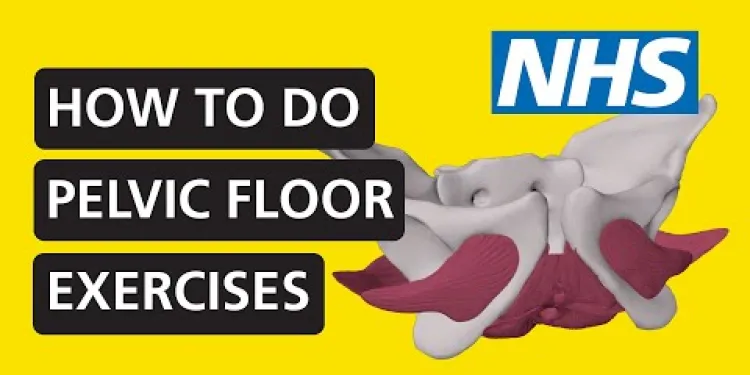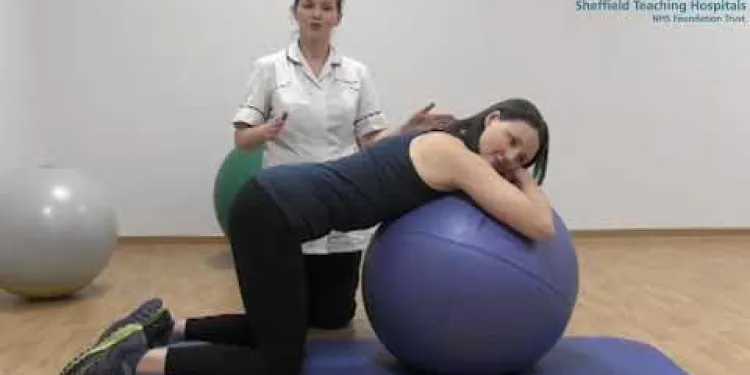Find Help
More Items From Ergsy search
-

Pelvic health: prolapse
Relevance: 100%
-

Pelvic health: prolapse
Relevance: 99%
-

Prolapse Management
Relevance: 67%
-

Prolapse Types and Tips
Relevance: 65%
-

Incontinence and Prolapse - Physiotherapy Advice
Relevance: 62%
-

Incontinence and Prolapse - Physiotherapy Advice
Relevance: 62%
-

Your pelvic health matters: insights from NHS clinicians
Relevance: 61%
-

Pelvic health: Urge Incontinence
Relevance: 45%
-

Pelvic Floor Exercises - Using Your Pelvic Floor to Calm Down Your Bladder
Relevance: 45%
-

The Pelvic Floor Muscles - Developing an Exercise Programme
Relevance: 44%
-

Pelvic health: stress urinary incontinence
Relevance: 44%
-

How to do pelvic floor exercises | NHS
Relevance: 43%
-

Pelvic Floor Exercises - Using Your Pelvic Floor to Calm Down Your Bladder
Relevance: 41%
-

Understanding Your Sexual Health - Pelvic Inflammatory Disease
Relevance: 40%
-

BSL Pelvic inflammatory disease (PID)
Relevance: 33%
-

Pelvic Girdle Pain Advice Class
Relevance: 33%
-

Mat and gym ball exercises with pregnancy related Pelvic Girdle Pain
Relevance: 28%
-

Understanding Your Sexual Health - Gonorrhoea
Relevance: 20%
-

Health and safety responsibilities
Relevance: 18%
-

Harshi’s learning disability annual health check and health action plan
Relevance: 17%
-

Understanding Mental Health in Children
Relevance: 16%
-

Mental Health Support Resources in the UK
Relevance: 16%
-

Mental Health Support Services in the UK
Relevance: 16%
-

Mental Health Resources for Families
Relevance: 16%
-

What is a public health funeral?
Relevance: 16%
-

Postpartum Health: Mother and Baby
Relevance: 16%
-

Health Officials Warn Against 'DIY' Health Remedies Amid Supply Chain Issues
Relevance: 16%
-

Accessing Mental Health Support Resources in the UK
Relevance: 16%
-

Advancements in Mental Health Resources for Families
Relevance: 16%
-

What is the impact of obesity on mental health?
Relevance: 15%
-

Mental Health Support Resources for Families
Relevance: 15%
-

Mental Health: Laura's Story | NHS
Relevance: 15%
-

Is Wegovy covered by health insurance?
Relevance: 15%
-

How are health services provided in prison?
Relevance: 15%
-

What health risks are associated with obesity?
Relevance: 15%
-

Mental Health Support for Families: Resources and Strategies
Relevance: 15%
-

Current Challenges in Youth Mental Health Services
Relevance: 15%
-

Mental Health Support for Families: Resources and Helplines
Relevance: 15%
-

What mental health resources are available for seniors?
Relevance: 15%
-

THE LAW IN 60 SECONDS | HEALTH AND SAFETY AT WORK
Relevance: 15%
Understanding Pelvic Health: Prolapse
Pelvic health is an essential aspect of overall well-being, especially for women. One common issue affecting pelvic health is prolapse. Pelvic organ prolapse occurs when the muscles and tissues supporting the pelvic organs weaken, causing these organs to drop from their normal position. This condition can affect the bladder, uterus, bowel, and rectum, leading to various symptoms and affecting quality of life.
Causes and Risk Factors of Prolapse
Several factors contribute to the development of pelvic organ prolapse. These include childbirth, particularly multiple or difficult deliveries, which can strain pelvic muscles. Age is another factor; as women age, their muscles naturally weaken, increasing the risk of prolapse. Additional risk factors include heavy lifting, chronic coughing, obesity, and genetics. Understanding these can help in both prevention and early diagnosis.
Symptoms of Pelvic Organ Prolapse
The symptoms of prolapse can vary depending on the organ affected. Common symptoms include a sensation of pressure or fullness in the pelvic area, a visible bulge in the vagina, urinary problems such as incontinence or difficulty emptying the bladder, and bowel issues. Some women may also experience discomfort during intercourse. Recognizing these symptoms early can lead to more effective management and treatment.
Diagnosis and Treatment Options
If prolapse is suspected, a healthcare provider can conduct a physical examination to diagnose the condition. Treatment options vary based on the severity of the prolapse. In mild cases, lifestyle modifications and pelvic floor exercises, such as Kegels, may be recommended. In more severe cases, pessary devices can provide support, or surgical intervention may be necessary. Discussing these options with a healthcare professional can help determine the most appropriate course of action.
Preventative Measures for Pelvic Health
Preventing prolapse involves maintaining good pelvic health. Regular pelvic floor exercises can strengthen the muscles supporting the pelvic organs, reducing the risk of prolapse. Maintaining a healthy weight, avoiding heavy lifting, and addressing chronic coughs or constipation can also help. Regular check-ups and open discussions with healthcare providers ensure any issues are addressed promptly.
Understanding Pelvic Health: Prolapse
Pelvic health is important, especially for women. Sometimes, a problem called prolapse can happen. Prolapse is when the muscles and tissues holding the organs in the pelvis become weak. This can cause the organs to move down from where they should be. It can affect the bladder, uterus, bowel, and rectum. Prolapse can cause different problems and make life harder.
Causes and Risk Factors of Prolapse
Many things can cause prolapse. Having babies, especially if it was more than one or hard to do, can strain the pelvic muscles. Getting older can make muscles weaker too, increasing the chance of prolapse. Other things that raise the risk include lifting heavy things, coughing a lot, being overweight, and family history. Knowing these can help with preventing and finding prolapse early.
Symptoms of Pelvic Organ Prolapse
Prolapse can cause different symptoms. Some women feel like there is pressure or fullness in the pelvic area. There might be a bulge in the vagina that you can see. Other signs include problems peeing, like leaking or trouble emptying the bladder, and issues with bowel movements. Some may feel pain during sex. Knowing these signs early can help manage and treat prolapse better.
Diagnosis and Treatment Options
If you think you have prolapse, a doctor can check to see if it's there by doing a physical examination. Treatments depend on how bad the prolapse is. For mild prolapse, changes in lifestyle and exercises for pelvic floor muscles, like Kegels, can help. If it's worse, a pessary, which supports the organs, might be used, or surgery might be needed. Talking with a doctor can help decide what is best.
Preventative Measures for Pelvic Health
To prevent prolapse, take care of your pelvic health. Doing pelvic floor exercises regularly keeps the muscles strong, helping to prevent prolapse. It's also good to keep a healthy weight, avoid lifting heavy things, and treat any long-term coughs or constipation. Visiting the doctor regularly and talking openly with them means any problems can be dealt with quickly.
Frequently Asked Questions
What is pelvic organ prolapse?
Pelvic organ prolapse occurs when one or more of the pelvic organs slip down from their normal position and bulge into the vagina. It can affect the bladder, womb, and bowel, among other organs.
What are the common symptoms of pelvic organ prolapse?
Common symptoms include a feeling of pressure or fullness in the pelvic area, a sensation of something coming down or out of the vagina, urinary incontinence, difficulty in bowel movements, and discomfort during sexual intercourse.
What causes pelvic organ prolapse?
Causes can include childbirth, aging, menopause, obesity, chronic coughing, heavy lifting, and previous pelvic surgery.
How is pelvic organ prolapse diagnosed?
Diagnosis typically involves a pelvic examination conducted by a healthcare professional, sometimes accompanied by imaging tests like an ultrasound or MRI.
Can pelvic organ prolapse be prevented?
While not all cases can be prevented, maintaining a healthy weight, avoiding heavy lifting, doing pelvic floor exercises, treating chronic coughing, and consuming a balanced diet can reduce risk factors.
What are pelvic floor exercises?
Pelvic floor exercises, also known as Kegel exercises, involve tightening and relaxing the muscles used to stop the flow of urine. These help strengthen the muscles supporting the pelvic organs.
When should I see a doctor about pelvic organ prolapse?
If you experience symptoms like a noticeable bulge in the vagina, pelvic discomfort, or urinary issues that affect your quality of life, consult a GP or specialist.
What treatment options are available for pelvic organ prolapse?
Options include lifestyle modifications, pelvic floor exercises, pessary devices, hormone therapy, and surgery, depending on the severity of the prolapse.
What is a pessary, and how does it help with prolapse?
A pessary is a device inserted into the vagina to support pelvic organs. It can provide relief from symptoms and is especially useful for women who wish to avoid surgery.
Is surgery always necessary for pelvic organ prolapse?
No, not always. Many cases can be managed with non-surgical options. Surgery is typically considered for severe cases or when non-surgical treatments fail to relieve symptoms.
What are the surgical options for treating pelvic organ prolapse?
Surgical options include pelvic floor repair, hysterectomy, or the use of surgical mesh to support weakened tissues. The choice of surgery depends on the individual's specific needs and overall health.
How long does recovery from prolapse surgery take?
Recovery can vary, but most individuals can resume normal activities within 6 to 8 weeks, with some restrictions on heavy lifting and strenuous exercise.
Can pelvic organ prolapse recur after treatment?
Yes, there is a possibility of recurrence, especially if underlying risk factors are not addressed. Regular pelvic floor exercises and lifestyle modifications can help reduce this risk.
Are there lifestyle changes that can help manage pelvic organ prolapse?
Yes, maintaining a healthy weight, quitting smoking, avoiding constipation, and performing regular pelvic floor exercises can help manage symptoms and prevent worsening prolapse.
Does pelvic organ prolapse affect sexual function?
It can affect sexual function, potentially causing discomfort during intercourse or decreased sensation. However, many women find that treatment helps alleviate these issues.
What is pelvic organ prolapse?
Pelvic organ prolapse is when organs in the lower belly slip out of place. These organs can be the bladder, bowel, or womb. They can push down on the vagina. This can make a person feel uncomfortable or like something is falling out.
If you have trouble reading, ask someone you trust to read with you. You can also use tools like audiobooks to listen to the words. Drawing pictures might help you understand better too.
Pelvic organ prolapse happens when one or more organs in the pelvis move out of place and push into the vagina. This can happen to the bladder, womb, and bowel, among other organs.
Tips to understand better:
- Think of the pelvis as a bowl holding important parts like the bladder, womb, and bowel.
- Sometimes these parts can slip and move where they shouldn’t, causing a bump inside the vagina.
What Happens When Pelvic Organs Drop Down?
When the organs in the lower part of your tummy drop down, it can cause:
- A feeling of pressure or something heavy in the lower belly.
- Pain in the lower back.
- Finding it hard to go to the toilet (to pee or poop).
- Feeling like something is coming out of the vagina.
If you feel these signs, it is a good idea to talk to a doctor. Using pictures or a diagram can help you understand better. Friends or family can also help explain things to you.
Some common signs are a feeling of heaviness or fullness in the lower belly, feeling like something is coming out of the vagina, leaking pee, trouble going poop, and feeling pain during sex.
What makes pelvic organs drop down?
There are many reasons this can happen:
Having a baby, getting older, women going through menopause, being very overweight, coughing a lot, lifting heavy things, and having surgery in the belly area before.
How do doctors find out if you have pelvic organ prolapse?
Doctors can check for pelvic organ prolapse in a few ways:
- Talking: The doctor will ask you questions about how you feel. They will want to know if you have any problems, like feeling pressure in your lower tummy or having trouble going to the toilet.
- Examination: The doctor might look at your pelvic area to see how things are. This helps them see if anything is not in the right place.
- Special Tests: Sometimes, doctors use machines to take pictures inside your body. This can help them see what's wrong.
If you have trouble understanding, ask someone you trust to help explain. You can also try drawing pictures to understand better.
To find out what's wrong, a doctor will check your tummy area. This is called a pelvic exam. Sometimes, the doctor might also use special pictures like an ultrasound or an MRI to look inside your body.
Can we stop pelvic organ prolapse from happening?
Sometimes you can't stop things from happening. But there are things you can do to help. Keep your weight healthy. Don't lift heavy things. Do exercises for your pelvic floor. If you cough a lot, see a doctor. Eat a healthy diet. These things can help lower your risk.
What are pelvic floor exercises?
Pelvic floor exercises are simple movements. They make your tummy, back, and bottom muscles strong. These muscles help you to wee and poo. They also help when you cough or sneeze.
How to do pelvic floor exercises:
- Find a quiet space. Sit or lie down.
- Squeeze the muscles that stop a wee. Hold for a count of 3. Then let go.
- Do this 10 times. Try to do it 3 times a day.
Extra help: You can ask a grown-up or a doctor to help you. You can also use phone apps. They can remind you to do the exercises.
Pelvic floor exercises are also called Kegel exercises. They are a way to make your muscles stronger. These are the muscles you use to stop peeing. When you do these exercises, you squeeze and then relax these muscles. This helps make the muscles around your tummy and bladder stronger.
Tip: If you find it hard to remember to do these exercises, you can use a reminder on your phone. You could also try doing them at the same time each day, like when you brush your teeth.
When should I visit a doctor about pelvic organ prolapse?
If you have any worries about something called pelvic organ prolapse, it is good to talk to a doctor. Here are some times you should definitely see a doctor:
- If you feel a heavy or pulling feeling in your lower tummy.
- If you notice a bulge or lump coming out of your private parts.
- If it's hard to go to the toilet or if you can't hold your pee.
- If you have any pain in your lower tummy area.
Talking to a doctor can help you feel better and find out what to do next. You can also use tools like pictures or models to understand better what the doctor tells you.
If you feel something like a lump in your vagina, feel pain in your pelvis, or have trouble going to the toilet that makes life hard, talk to a doctor or a specialist.
What treatments can help with pelvic organ prolapse?
Pelvic organ prolapse happens when organs like the bladder move down from their normal place. Here are some treatments that might help:
- Exercising Muscles: You can do special exercises to make your tummy and pelvic muscles stronger. These are called pelvic floor exercises or Kegels.
- Devices: A doctor may give you a small device called a pessary. It goes into your body to help support the organs.
- Medicine: Sometimes, doctors give medicine to make the pelvic area healthier.
- Surgery: In some cases, doctors might suggest an operation to fix things.
If you or someone you know has pelvic organ prolapse, it is important to talk to a doctor. They will help you pick the best treatment. You might also want to bring a friend or family member to your doctor visits to help remember information.
You have some choices. You can try changing your daily habits, doing special exercises to make your muscles stronger, using a small device called a pessary, taking hormone medicine, or having an operation. What you choose depends on how bad the prolapse is.
What is a pessary, and how does it help with prolapse?
A pessary is a small, soft object that goes inside the body.
It helps hold things up in the right place.
This can help if something inside the body is falling down. This is called a prolapse.
If you find reading hard, you can ask someone to read the words out loud for you.
A pessary is a small thing that goes inside the vagina. It helps hold up parts inside the body. This can make you feel better. It is good for women who don't want to have surgery.
Do you always need an operation for pelvic organ prolapse?
No, you don't always need surgery. Many times, doctors can help you feel better without it. Surgery is usually for serious problems or if other treatments don't work.
What operations can help when the organs in the pelvis fall out of place?
There are different types of surgeries to help fix problems inside the body:
- One option is to fix the muscles at the bottom of the belly (pelvic floor) so they work better.
- Another option is to take out the womb (hysterectomy).
- Another way is to use a special net (surgical mesh) to make weak parts stronger.
The doctor will choose the best surgery for each person based on what they need and how healthy they are.
How long does it take to get better after prolapse surgery?
Getting better can be different for everyone. Most people can start doing their usual things again in 6 to 8 weeks. But they should be careful and not lift heavy things or do hard exercises until they are fully better.
Can pelvic organ prolapse happen again after treatment?
Pelvic organ prolapse is when muscles inside the body are weak, and organs like the bladder, womb, or bowel move down. Even after treatment, prolapse can sometimes come back. It is like when you fix a toy, but it breaks again later.
Here are some ways to help:
- Do exercises to make your muscles strong. Ask a doctor or trusted adult for help learning how.
- Some people find special tools, like a vaginal pessary, can help hold things in place.
- Go for regular check-ups with your doctor.
It's important to ask questions and talk to your doctor if you are worried.
Yes, it can happen again. This is more likely if the original problem isn't fixed. Doing pelvic floor exercises often and changing some habits can help stop it from happening again.
Can changes in daily habits help with pelvic organ prolapse?
Yes, some changes can help! Here are a few things you can try:
- Exercise: Do gentle exercises, like walking or swimming. Pelvic floor exercises can be very helpful too.
- Healthy Eating: Eat plenty of fruits, vegetables, and fiber to help digestion.
- Manage Weight: Try to stay at a healthy weight to reduce pressure on your pelvis.
- Avoid Heavy Lifting: Do not lift heavy things too often if you can avoid it.
- Quit Smoking: If you smoke, try to quit as it can make things worse.
It can help to talk to a doctor or a therapist. They can give you more advice and show you special exercises. You can also look for apps or videos online to guide you with exercises.
Yes, keeping a healthy weight, not smoking, avoiding the need to strain while going to the toilet, and doing exercises for your pelvic muscles can help manage symptoms and stop prolapse from getting worse.
Can pelvic organ prolapse change how you feel during sex?
Pelvic organ prolapse means when organs like the bladder, bowel, or uterus move from where they should be inside the body. This can make sex feel different. If you're worried, talk to a doctor or nurse. They can help you feel better.
You can try using pillows to find a comfy position. Breathing slowly can also help you relax. Remember, it’s okay to take breaks or stop if it doesn’t feel good.
Problems can happen with sex, like feeling pain or less feeling. But getting help can make things better for many women.
Useful Links
- Ergsy carfully checks the information in the videos we provide here.
- Videos shown by Youtube after a video has completed, have NOT been reviewed by ERGSY.
- To view, click the arrow in centre of video.
- Most of the videos you find here will have subtitles and/or closed captions available.
- You may need to turn these on, and choose your preferred language.
- Go to the video you'd like to watch.
- If closed captions (CC) are available, settings will be visible on the bottom right of the video player.
- To turn on Captions, click settings .
- To turn off Captions, click settings again.
More Items From Ergsy search
-

Pelvic health: prolapse
Relevance: 100%
-

Pelvic health: prolapse
Relevance: 99%
-

Prolapse Management
Relevance: 67%
-

Prolapse Types and Tips
Relevance: 65%
-

Incontinence and Prolapse - Physiotherapy Advice
Relevance: 62%
-

Incontinence and Prolapse - Physiotherapy Advice
Relevance: 62%
-

Your pelvic health matters: insights from NHS clinicians
Relevance: 61%
-

Pelvic health: Urge Incontinence
Relevance: 45%
-

Pelvic Floor Exercises - Using Your Pelvic Floor to Calm Down Your Bladder
Relevance: 45%
-

The Pelvic Floor Muscles - Developing an Exercise Programme
Relevance: 44%
-

Pelvic health: stress urinary incontinence
Relevance: 44%
-

How to do pelvic floor exercises | NHS
Relevance: 43%
-

Pelvic Floor Exercises - Using Your Pelvic Floor to Calm Down Your Bladder
Relevance: 41%
-

Understanding Your Sexual Health - Pelvic Inflammatory Disease
Relevance: 40%
-

BSL Pelvic inflammatory disease (PID)
Relevance: 33%
-

Pelvic Girdle Pain Advice Class
Relevance: 33%
-

Mat and gym ball exercises with pregnancy related Pelvic Girdle Pain
Relevance: 28%
-

Understanding Your Sexual Health - Gonorrhoea
Relevance: 20%
-

Health and safety responsibilities
Relevance: 18%
-

Harshi’s learning disability annual health check and health action plan
Relevance: 17%
-

Understanding Mental Health in Children
Relevance: 16%
-

Mental Health Support Resources in the UK
Relevance: 16%
-

Mental Health Support Services in the UK
Relevance: 16%
-

Mental Health Resources for Families
Relevance: 16%
-

What is a public health funeral?
Relevance: 16%
-

Postpartum Health: Mother and Baby
Relevance: 16%
-

Health Officials Warn Against 'DIY' Health Remedies Amid Supply Chain Issues
Relevance: 16%
-

Accessing Mental Health Support Resources in the UK
Relevance: 16%
-

Advancements in Mental Health Resources for Families
Relevance: 16%
-

What is the impact of obesity on mental health?
Relevance: 15%
-

Mental Health Support Resources for Families
Relevance: 15%
-

Mental Health: Laura's Story | NHS
Relevance: 15%
-

Is Wegovy covered by health insurance?
Relevance: 15%
-

How are health services provided in prison?
Relevance: 15%
-

What health risks are associated with obesity?
Relevance: 15%
-

Mental Health Support for Families: Resources and Strategies
Relevance: 15%
-

Current Challenges in Youth Mental Health Services
Relevance: 15%
-

Mental Health Support for Families: Resources and Helplines
Relevance: 15%
-

What mental health resources are available for seniors?
Relevance: 15%
-

THE LAW IN 60 SECONDS | HEALTH AND SAFETY AT WORK
Relevance: 15%


